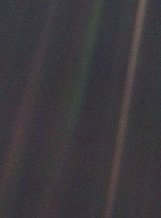Reflections on Bertoia’s “View of the Earth from Space”
Learn more about the work of Harry Bertoia. Read “The Shopping-Mall Legacy of a Mid-Century Sculptor.”
A new book and major exhibition show how artist Harry Bertoia cemented his status by putting his work in places where it could be seen by everyone.
Watch the Harry Bertoia Symposium, here.
Harry Bertoia Ehibition
Sculpting Mid-Century Modern Life
January 29, 2022 - April 24, 2022
My work interprets historic milestones of science and speaks to the human impact on our rapidly changing world. Science, like art, and particularly abstract art, explores the unknown. Satellite and drone photography have opened up incredible opportunities for me to explore and visually translate the otherwise invisible. My work expresses a narrative interpretation of space exploration starting with Apollo 11 to the Space Shuttle Voyager and the birth of the Hubble Space Telescope.
More currently, the International Space Station and the satellite photography now possible, has allowed NASA missions such as the New Horizons Pluto Flyby revealed high resolution portraits of its glacial and rock surface. The Cassini Mission, captured for the first time, actual images of its thousands of rings and Shepard Moons that were discovered by Voyager. Additionally, the discovery of gravitational waves and shifts in the polar ice caps has also moved me to create contemporaneous work relevant to what is happening in our world now. My art charts a course in discovery, history and astronomy and its relation to our planet.
I can imagine Harry Bertoia at work in 1962, creating ‘View of the Earth from Space’ which hangs at Dulles Airport in Washington D.C. while John Glen and the Mercury 7 astronauts first orbited the Earth. Each decade since then, space exploration and planetary science has rapidly evolved. The once unimaginable grandeur of the Earth as seen from space is now clearly visible from many new vantage points allowed by technology and the continued human hunger for exploration.
Inspired by Harry Bertoia’s “View of the Earth from Space”, my vision for a public art installation reflects how our view of Earth has changed and how far space exploration has come while paying thoughtful homage to the piece Bertoia created in 1962. A series of eight panels representing each decade, 1960-present with the final two panels exploring ideas about what is still to come in space exploration:
Panel 1: 1960’s—An homage to the original artwork, ‘View of Earth from Space’ using historical images from the early Mercury-Atlas orbital missions as inspiration.
Panel 2: 1970’s—In 1971 maintained orbit around another planet, Mars, was achieved, later in the decade the Skylab program launched and Voyager 1 & 2 were taking a ‘Grand Tour’ through the solar system. ‘The Pale Blue Dot’, a captivating image of tiny Earth seen across the vastness of space became an iconic image. The basis for this panel is images of Earth captured by these probes and a visual reference to ‘The Pale Blue Dot.’
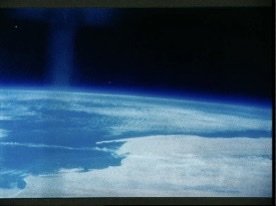
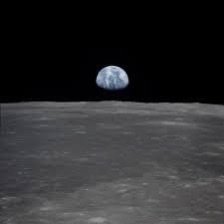
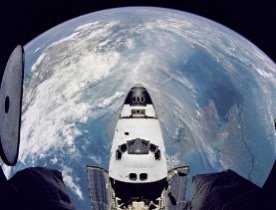

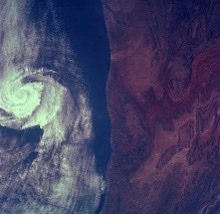

Panel 3: 1980’s—The 80’s ushered in the Space Shuttle program and a veritable bridge from Earth to the stars was built. In the historical images of this era, we really see ourselves looking down on the earth, the mechanical arm or a wing of a space shuttle hovering serenely above its home.
Panel 4: 1990’s—The launch of the Hubble Space Telescope in the 90’s made it possible for us to see farther, wider and more deeply than ever before. A long-time source of inspiration for my work, Panel 4 will reference these images, and other images from the great observatories looking back at Earth.
Panel 5: 2000’s—Rovers on Mars, spacewalks and the International Space Station. Could Harry Bertoia have imagined what was to come after those first orbital missions in the 1960’s? This panel will have a juxtaposition in scale representing the vastness of space and the small hands of creation that continually reach to know and understand it.
Panel 6: 2010’s—The boom of private space flight and a recor- breaking space jump. Inspiration for this panel is drawn from images of the free fall to Earth, faster than the speed of sound.
Panel 7-8: 2020-2030—The final two panels reach for a sense of wonder about what the ensuing decades of space exploration and planetary science will bring. How will we see the Earth then? How will human impact alter the look of the Earth? How will humans continue to explore our planet and it’s place in the universe?
I work with the ancient medium of encaustic—beeswax, resin and pigment. The process by which I work, lends itself ideally to this particular project as I have innovated specific ways to depict geologic terrain as seen from above using encrusted layers of wax. Beeswax can be built up, carved, etched and molded, it is a physical three dimensional substance that will grow scarce as our bee population dwindles. I am continually compelled to link this ancient painting medium with current-day science and technology to engage the viewer and remind us that the past always informs the future.



